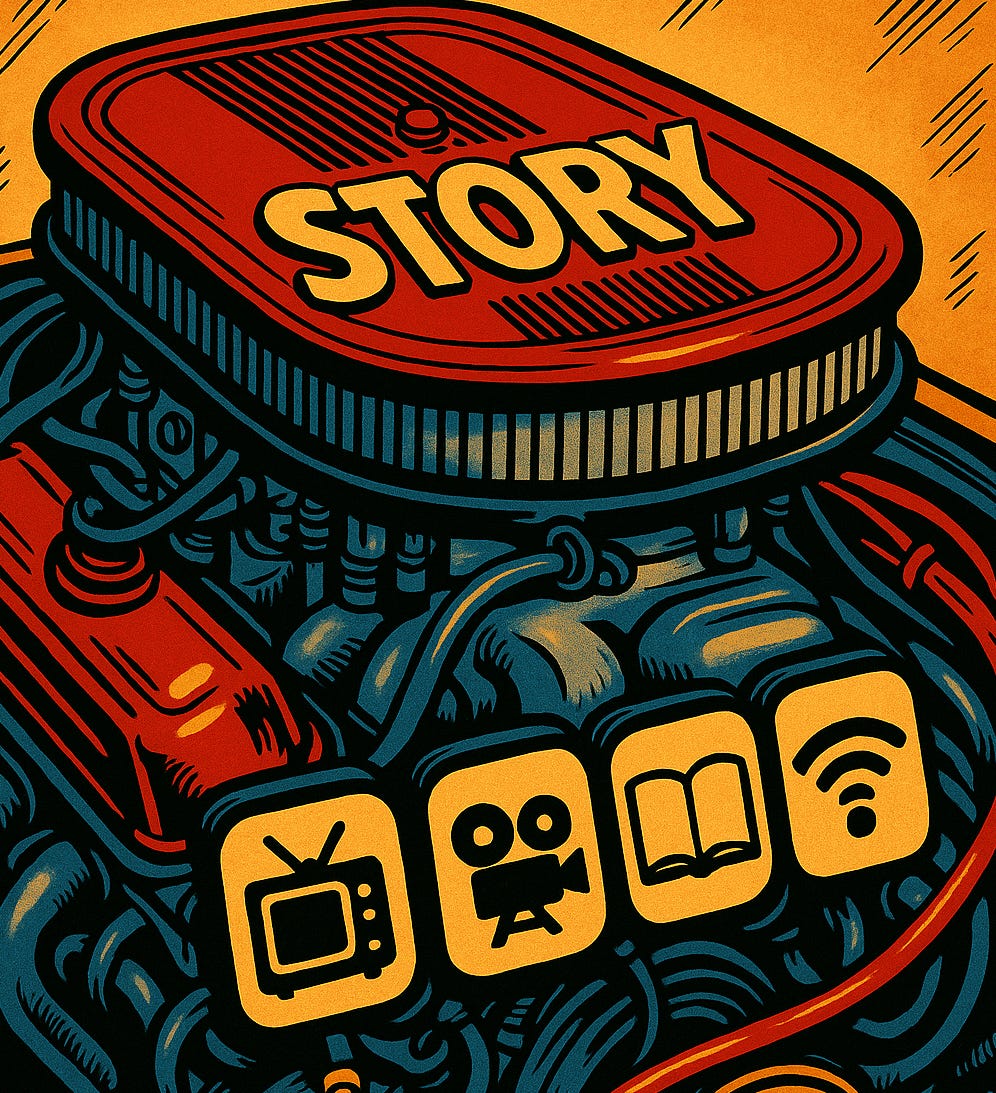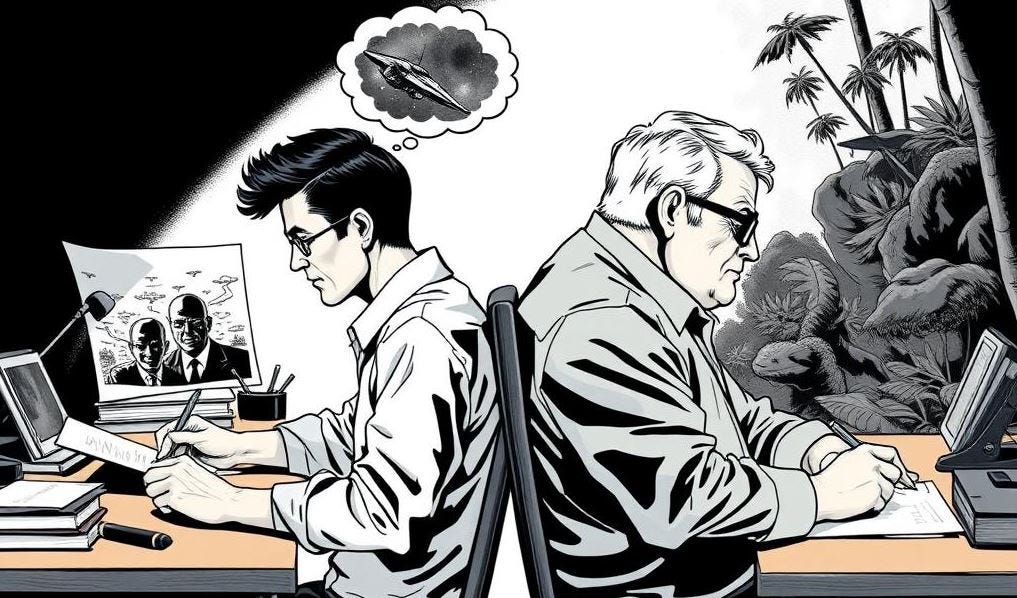Developing Your Story Engine
Creating Sustainable Narrative Drive
What keeps a reader flipping pages long after bedtime? What hooks someone into a Netflix series so deeply they say "just one more episode" five times in a row?
At the heart of all truly gripping storytelling lies a strong, churning story engine… a creative machine built from tension, conflict, character needs, and narrative momentum.
Think of it like the engine in a car. Your story engine doesn’t just look good or sound cool. It makes the whole thing move. It gives your story its pace, its energy, and most importantly, its ability to go the distance. Without one, you’ve got a flashy chassis that just sits there.
In this post, we’ll break down what a story engine really is, explore a few common types, show you how to identify your story’s core conflict, and give you tools to build tension and rich character dynamics that keep your narrative revving for the long haul.
What Is a Story Engine, Exactly?
At its core, a story engine is the underlying mechanism that generates momentum in your story. It’s what keeps characters in motion, problems unfolding, and readers engaged. It’s made up of conflict, stakes, character desire, and change. When working properly, it feeds itself.
This means that after every chapter or episode, something happens that leads organically into what must come next. The engine is sustainable, it doesn't need constant reinvention because it's inherently built to create tension and transformation.
There isn’t just one kind of story engine, though. Let’s take a peek under the hood.
Types of Story Engines (With Some Handy Examples)
Different stories get their momentum from different places. Here are a few primary engine types, each suited for different narrative terrains:
Premise-Driven Engines
These stories revolve around a central “what if?” idea. The narrative is propelled by the implications of that premise. Think Groundhog Day… what if someone lived the same day over and over? Or Jurassic Park… what if we brought dinosaurs back to life?
In these stories, the world or concept itself demands exploration. Characters may change, sure, but it’s the premise that fuels the plot.
Character-Driven Engines
These are powered by internal desires, flaws, or contradictions within characters. The plot often adapts to fit what the characters need or fear. Consider Mad Men, where Don Draper’s identity issues drive years of story, or Lady Bird, where teenage rebellion clashes with maternal love.
These stories focus more on how people change over time and how that change creates ripple effects.
Goal-Driven Engines
Here, protagonists chase something specific. A treasure, a job, redemption, revenge, you name it. The goal creates a path forward. Obstructions and setbacks keep the engine humming. A clear goal often helps keep a story focused and kinetic. Think The Lord of the Rings or Ocean’s Eleven.
Relationship-Driven Engines
Tension and conflict arise from evolving dynamics between people. Romance, rivalry, betrayal, reconciliation… these become the pulse of the story. Sitcoms like Friends or family dramas like This Is Us thrive on shifting interpersonal bonds.
In stories like these, change comes not from world events or personal goals alone but from how characters connect, or don’t.
Many great stories blend more than one engine type. Breaking Bad, for instance, starts as goal-driven (make money for family) but becomes character-driven (Walter’s descent into power hunger) and relationship-driven (his dynamic with Jesse and Skyler).
So how do you know which engine suits your story?
Find Your Core Conflict (and Let It Lead the Way)
Every story needs conflict. But not all conflict works the same. To find your story engine, you’ve got to lock in on the core type of conflict that’s going to power it.
Here are some basic conflict models, simplified to keep things clear:
Person vs. Self: Inner turmoil drives the narrative (good for character-driven engines).
Person vs. Person: A direct rival, antagonist, or foiling figure keeps the story in motion (relationship-driven or goal-driven).
Person vs. Society: A protagonist takes on institutions, cultural norms, or large systems (great for premise-driven engines).
Person vs. Nature/Fate: Survival stories, disasters, or larger-than-life forces shape the journey.
Ask yourself: What’s the essential struggle your character(s) face? What keeps pressure on them chapter after chapter?
Let’s say your story is about a teenage girl trying to win a science fair. On the surface, it’s goal-driven. But if she’s also doing this to prove her worth to a disapproving parent, then there’s internal conflict too. If she has to outshine a longtime frenemy, you’ve got personal rivalry baked in. That’s a layered engine.
Now that we’ve got conflict in place, let’s talk fuel.
Techniques for Building Sustainable Tension
Without tension, even the most dazzling premise fizzles out. So how do you keep readers caring, chapter after chapter? Here are some go-to tools:
Stakes That Rise (and Matter)
The reader must feel the cost of failure. It doesn’t always have to be life-or-death. Emotional stakes, like losing a friend or giving up a dream, can pack just as much punch.
Start small, then escalate. What begins as a bad grade turns into school expulsion. What starts as a missed dinner leads to divorce. Layer your stakes so that tension deepens as the story unfolds.
Ticking Clocks
Deadlines create urgency. These can be literal (“find the bomb before midnight”) or emotional (“convince her to stay before the plane leaves”).
You don’t need clocks in every scene, but sprinkling time constraints throughout adds heat. Characters can’t wait forever, and readers shouldn’t feel like they could either.
Dramatic Irony
When the audience knows something the character doesn’t? Delicious tension.
Use this to your advantage. If we know a surprise party is being planned and the protagonist thinks everyone forgot their birthday, we feel that delightful cringe as the gap between character belief and reality widens. The longer that gap stretches, the more engaging it becomes.
This works wonders in thrillers, romances, comedies… even tragic tales.
Creating Dynamic Relationships That Keep Stories Alive
Characters aren’t static. They evolve. And when two or more evolving people collide, that’s where real storytelling magic happens.
Here’s how to build character relationships that generate ongoing plot:
Opposing Desires
Put two characters together who want different things. Maybe they both love the same person. Maybe one wants security while the other craves chaos. The push-pull keeps scenes electric.
Give each character believable motivations. The tension isn’t about good versus evil, it’s about conflicting truths.
Hidden Truths and Revelations
A secret kept is a story waiting to erupt. Maybe it’s a past betrayal. A concealed identity. An unspoken love.
Don’t spill everything at once. Let characters keep secrets from each other, then trickle out those reveals to stir the pot. As new information surfaces, the relationship shifts.
Shifting Power Dynamics
Power isn’t static in real life and it shouldn’t be in your story. Characters should gain, lose, and fight for control within their relationships.
This doesn’t just apply to enemies. In a romance, who’s chasing whom can flip. In a buddy-cop duo, the mentor might fall apart while the rookie rises.
Dynamic relationships are engines in themselves… changing roles, power, and emotions keep readers glued.
A Quick Recap (Before You Fire Up That Engine)
Let’s pull this all together, nice and tidy:
A story engine is what makes your plot move. It’s the mix of conflict, character desire, and tension that keeps the narrative charging forward.
Different types of engines-premise-driven, character-driven, goal-driven, and relationship-driven, offer unique fuel sources. Your story might use just one or a blend.
Conflict is your compass. Know whether your core struggle is internal, relational, systemic, or existential.
Sustainable tension comes from rising stakes, ticking clocks, and dramatic irony. Use these tools to make readers uneasy… in a good way.
Character relationships should be alive. Give them friction, secrets, and changing power dynamics. Don’t let things settle for too long.
Final Thought: Your Engine Doesn’t Have to Roar… Just Run
You don’t need explosions or cliffhangers on every page. What matters is that something, some force, is always in motion beneath the surface. A good story engine hums. It makes you want to know what happens next.
So whether you’re writing a quiet indie drama, a twisty sci-fi thriller, or a sprawling fantasy saga, focus on building that engine. Because once it’s running smooth? The story almost writes itself.
Now grab your pen, or open that laptop, and start your engine.
About the Authors:
Phil Zizza and Wade Peña bring over 60 years of combined entertainment industry experience to their writing. From LA to NY to Orlando, they've worked on the writing, consulting, and producing sides of top TV, film, and animation projects.
Ready to elevate your storytelling?
Discover the professional techniques for story structure and pitching in their new book, "The Series Development Playbook."



